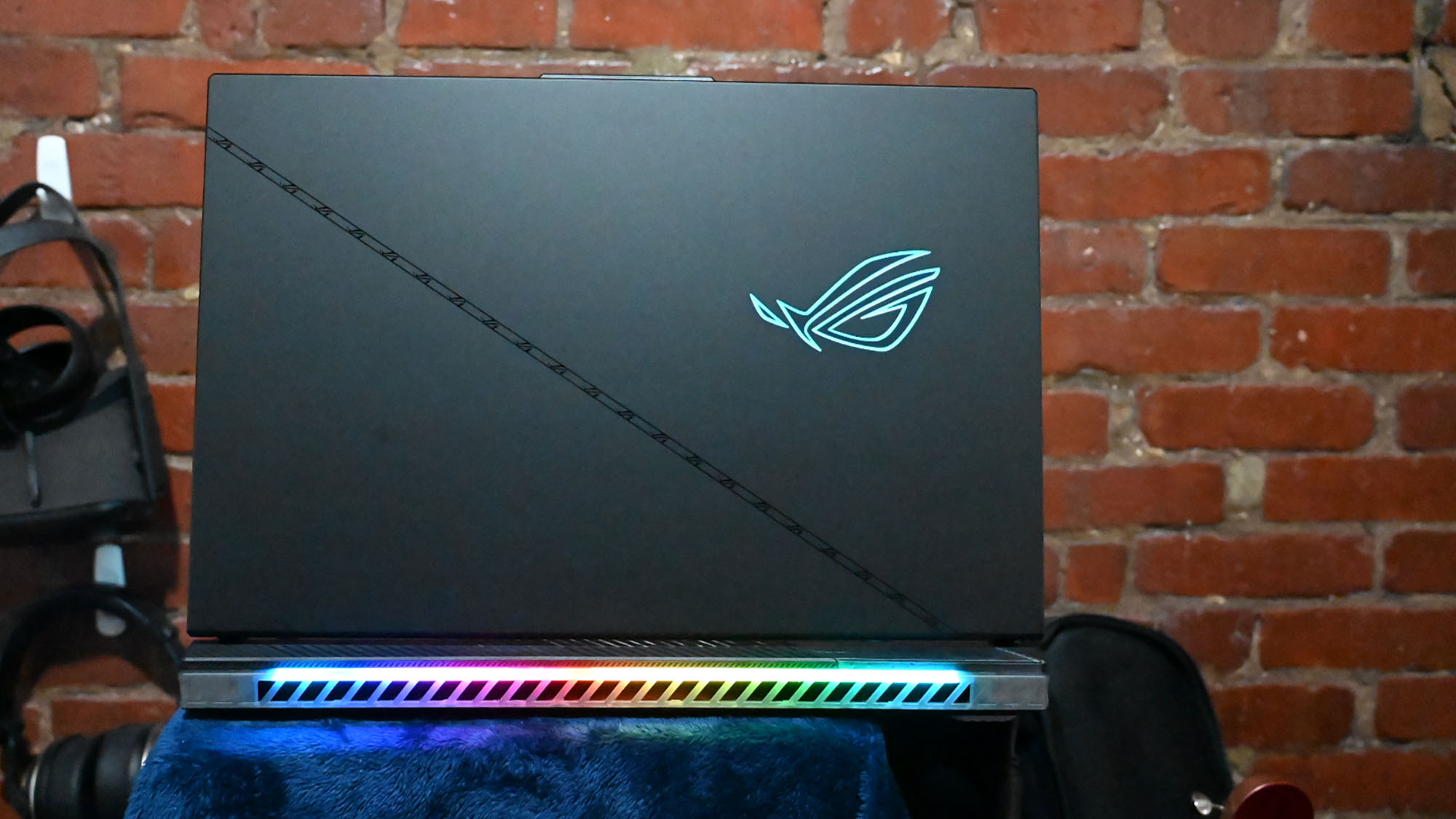Laptop Mag Verdict
With its high-powered components, beautiful display and excellent audio, the Asus ROG Strix Scar 18 leaves a swath of destruction in its wake and leaving no prisoners.
Pros
- +
Flashy, futuristic design
- +
Captivating display
- +
Full, balanced audio
- +
Impressive overall and gaming performance
Cons
- -
Pricy
- -
Webcam could be better
- -
Below-average battery life
Why you can trust Laptop Mag
Price: $3,699
CPU: Intel Core i9-13900HX
GPU: Nvidia GeForce RTX 4090
RAM: 32GB
Storage: dual 1TB SSD in RAID 0
Display: 18-inch, QHD+ (2560 x 1600), 240Hz
Battery: 90Whr, 4:26
Size: 15.7 x 11.6 x 0.9~1.2 inches
Weight: 6.8 pounds
Usually, Asus Strix-line of laptops are decidedly mid. Not as flashy as the top-tier Zephyrus line, but far from the entry-level Tuf line. But with the Asus ROG Strix Scar 18, you can put that mid description where it belongs –– in the dumpster with the trash pandas. From its futuristic design, panel, excellent audio and comfortable keyboard, the Scar 18 is an excellent desktop replacement.
But those are only the topping on this delectable win sundae. The real stars of this show are the components: the Intel Core i9 processor and Nvidia’s RTX 4090 GPU. It’s a formidable combination that laid waste to the competition. In fact, the Strix Scar 18 only has two weaknesses. 1. All that power is a battery life killer. 2. At $3,699, only the most deep pocketed gamers are going to get anywhere near this baby. 3. The webcam could be better.
However, if you can look past that, you’ve got a monster of a gaming laptop on your hands, one that easily struts its way onto our best gaming laptops and best Asus laptops page. Read on for a taste of the awesomeness.
Asus ROG Strix Scar 18 pricing and configurations
Gird your wallets because the Asus ROG Strix Scar 18 is coming in hot. My $3,699 review unit features a 2.2-GHz Intel Core i9-13900HX CPU, 32GB of RAM, two 1TB PCIe Gen 4.0 NVMe SSD in RAID 0 configuration, an Nvidia GeForce RTX 4090 GPU with 16GB of VRAM and a 18-inch, 2560 x 1600 Nebula Display with a 240Hz refresh rate.
The laptop is currently the only configuration available.
Asus ROG Strix Scar 18 design
The Asus ROG Strix Scar 18 is a futuristic stunner. The lid is made from a cool-to-the-touch black aluminum. A glossy strip with tiny ROG emblems diagonally cuts acts the lid with a giant LED-backlit version of the symbol in the center left. The vents are made of transparent plastic where the top lights up. While the hinge is totally plastic and the majority is black, a small removable magnetic tag called a Customizable Armour Cap is made from the clear plastic on the vents. However, if you don’t want the two-toned aesthetic, you can swap it out for the black opaque tag that ships with the laptop. You can also create your own via a 3D printer.
But the fun really begins when you open the laptop, The rear vent lighting gives you a mock K.I.T.T. effect with red scrolling lights while the emblem begins cycling through colors. A sword unsheathing sound effect plays and the keyboard mimics the lid’s logo with its rainbow light show. The deck is made of a semi-translucent plastic that fades to black about a quarter of the way down from the top with the right side of the palm rest rocking that ROG strip. Instead of a recess, the full-sized keyboard is embedded in the deck above the touchpad. The power button is located above the Home/End key.
The sides of the Strix are transparent with the front lip playing host to more attention-grabbing LED backlighting.
The Strix Scar 18 (15.7 x 11.6 x 0.9~1.2 inches) is on the heavier end of the spectrum at 6.8 pounds, but considering it’s an 18-inch system, that’s pretty lightweight. The Alienware X17 (15.7 x 11.8 x 0.8 inches) isn’t too far behind at 6.5 pounds. The MSI GE76 Raider 12UHS (15.3 x 11.2 x 1 inches) and Razer Blade 17 (15.6 x 10.2 x 0.8 inches) are slightly lighter at 6.4 and 6.1 pounds respectively.
Asus ROG Strix Scar 18 ports
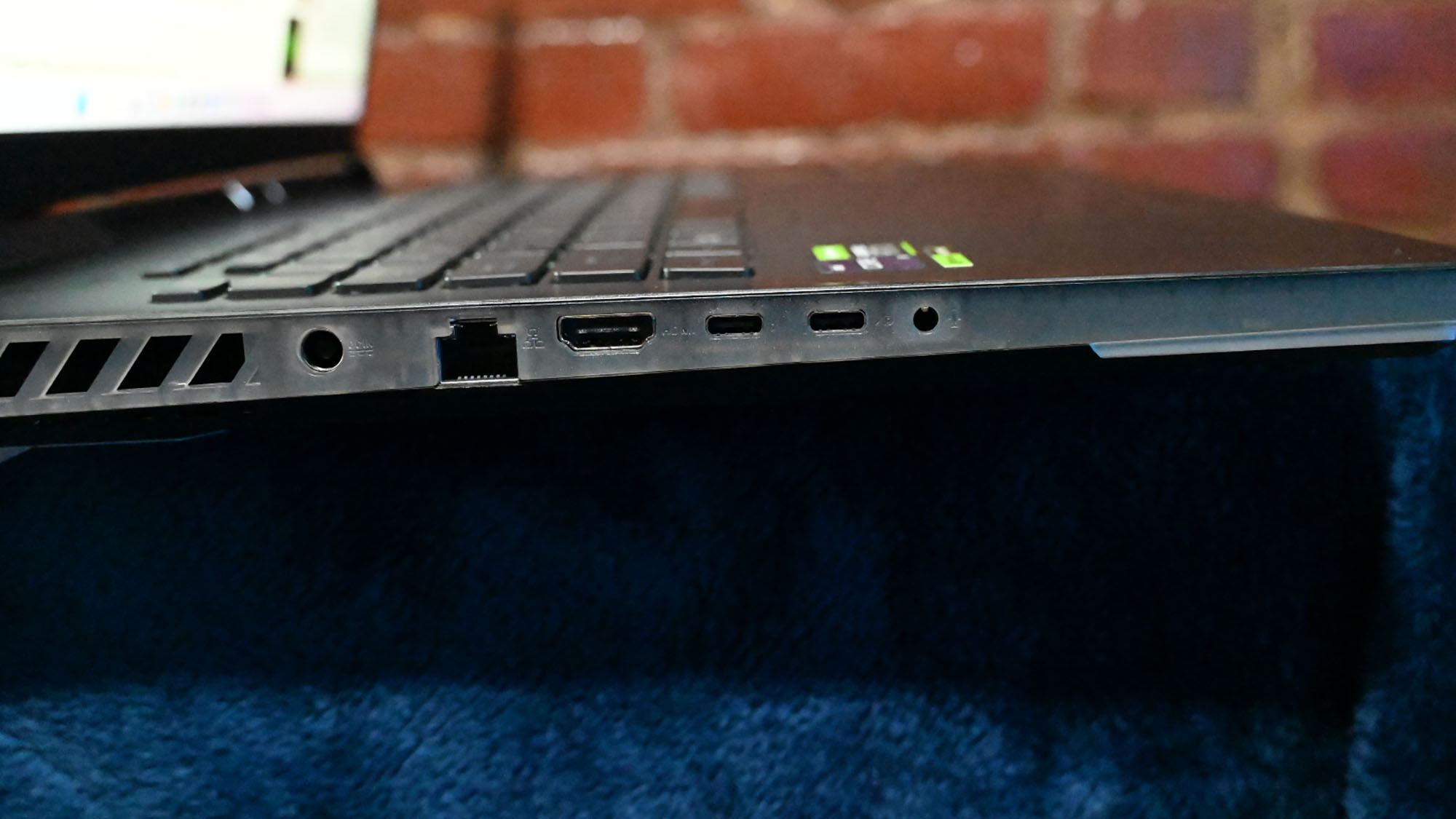
The Strix Scar 18 has enough ports to support a small gaming ecosystem. On the right, you have two USB 3.2 Type-A Gen 2 ports. On the left sits a Thunderbolt 4 port, a USB 3.2 Type-C Gen 2 ports, a HDMI 2.1, a LAN port and the DC input.
Asus ROG Strix Scar 18 display
There’s nothing worse than a washed-out, dim display, especially on a gaming laptop. Thankfully, that’s not a concern with the Strix Scar 18. On the contrary, the system delivers bright pops of color, sharp detail and silky smooth rendering by way of the 18-inch, 2560 x 1600, ROG Nebula display.
That all came in handy when watching a trailer for “1-800-Hot-Nite.” Despite its matte finish, the panel did a really good job in conveying color as evidenced by actor’s Dallas Dupree Young’s caramel complexion awash in red light. Details were fine enough that I saw the individual scales on the reticulated python around the actor’s neck as well as the small beads of sweat gathering on his forehead.
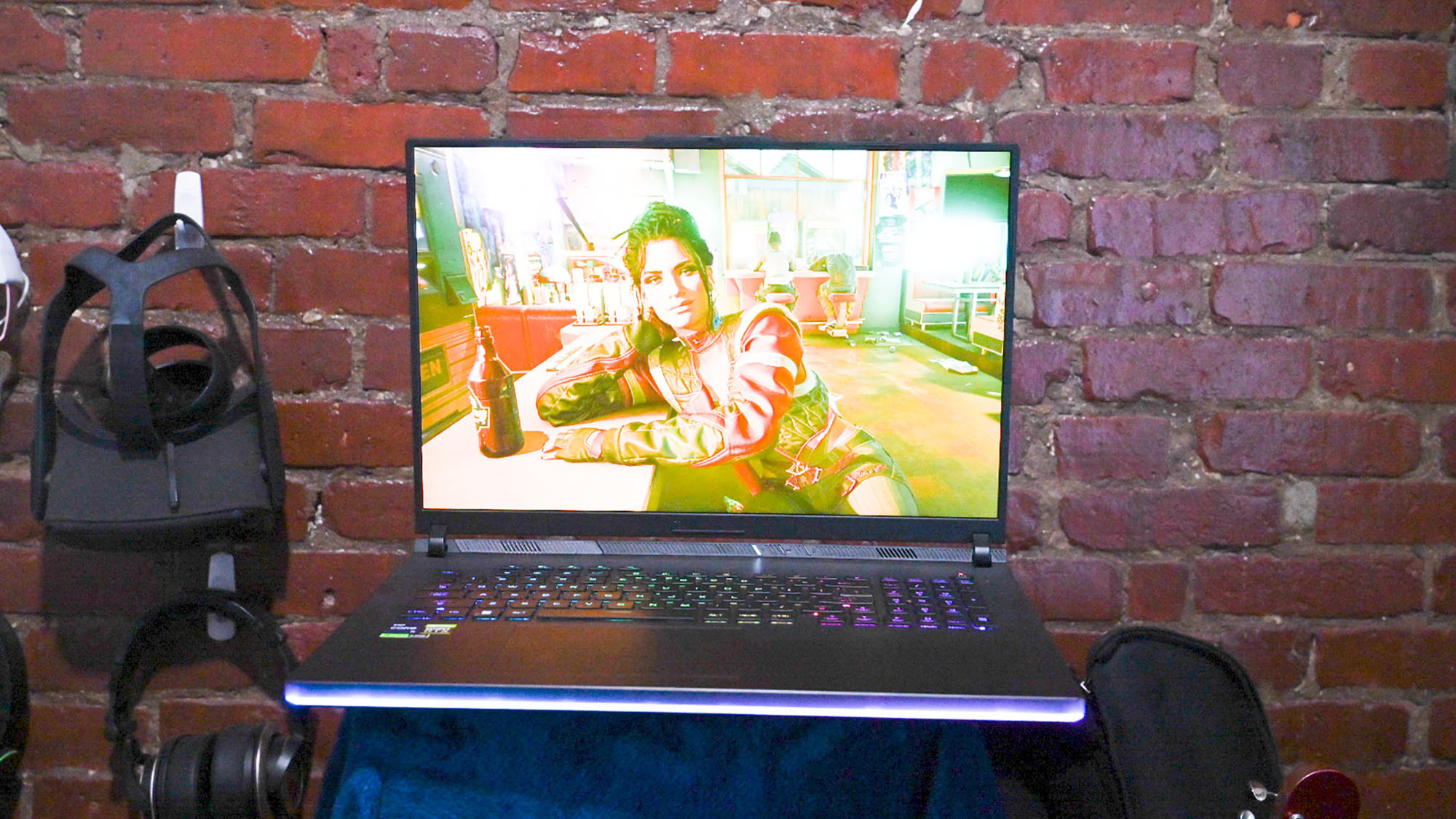
Asus promised deep blacks from the 16:10 aspect ratio panel and they definitely delivered. It felt like Cyberpunk 2077 was made for the Strix as the appropriately named Night City provided the perfect backdrop. The inky black sky only helped to magnify all the neon lighting in the futuristic setting. It made everything that much more lurid.
I got plenty of use from that 240Hz refresh rate as I played CyberPunk. Paired with Nvidia’s G-Sync (adaptive sync technology) and Advanced Optimus technology (uses MUX switch to switch between integrated and discrete graphics, I saw nothing but clean rendering and high frame rates as I blasted my way through Cyberpunk 2077.
| DCI-P3 color gamut percentage | |
| Asus ROG Strix Scar 18 | 77.5% |
| Alienware X17 | 76% |
| MSI GE76 Raider 12UHS | 74.5%% |
| Razer Blade 17 | 84% |
I was surprised to see the Scar 18’s 77.5% on the DCI-P3 color gamut benchmark fell below the 86.1% premium gaming laptop average. It was still better than the Alienware (76%) and Raider (74.5%), but not enough to overcome the Blade 17’s 84%.
The Scar 18 rallied on our brightness test, averaging 402 nits. That’s brighter than the 349-nit average as well as the Alienware (325 nits), Blade 17 (276 nits), Raider (259 nits).
| Display Brightness Average (Nits) | |
| Asus ROG Strix Scar 18 | 402 nits |
| Alienware X17 | 325 nits |
| MSI GE76 Raider 12UHS | 259 nits |
| Razer Blade 17 | 276 nits |
If you want to try to adjust your view, the Strix Scar 18 comes with both Dolby Vision HDR and Asus’ GameVisual utility. Both software allows you to switch between presets to get the best visual experience. And while many people might think the Dolby software is the way to go, I actually prefer GameVisual in this case as it has more presets (eight to Dolby’s three), plus you can manually adjust color temperature and even calibrate the color.
No matter which software you use, I recommend the Vivid setting as it gives the best hues.
Asus ROG Strix Scar 18 audio
Nine times out of ten, I’m not a fan of bottom-mounted speakers. But audio on the ROG Strix Scar 18 sounds amazing, speaker placement be damned! With a handy assist from the onboard Dolby Atmos software, the notebook’s four-speaker setup massaged my ears in strong piano, crisp drums and cymbals, rich horns and Lelah Hathaway’s gorgeous vocals accompanied by a slightly submerged background vocal on Robert Glasper’s take on the Sade classic, “Cherish The Day.”
I found that Dolby’s Dynamic setting gave the loudest results, but Music with the Balanced subsetting gave the best performance for music listening, while Game with the Detailed subsetting worked best for me while gaming.
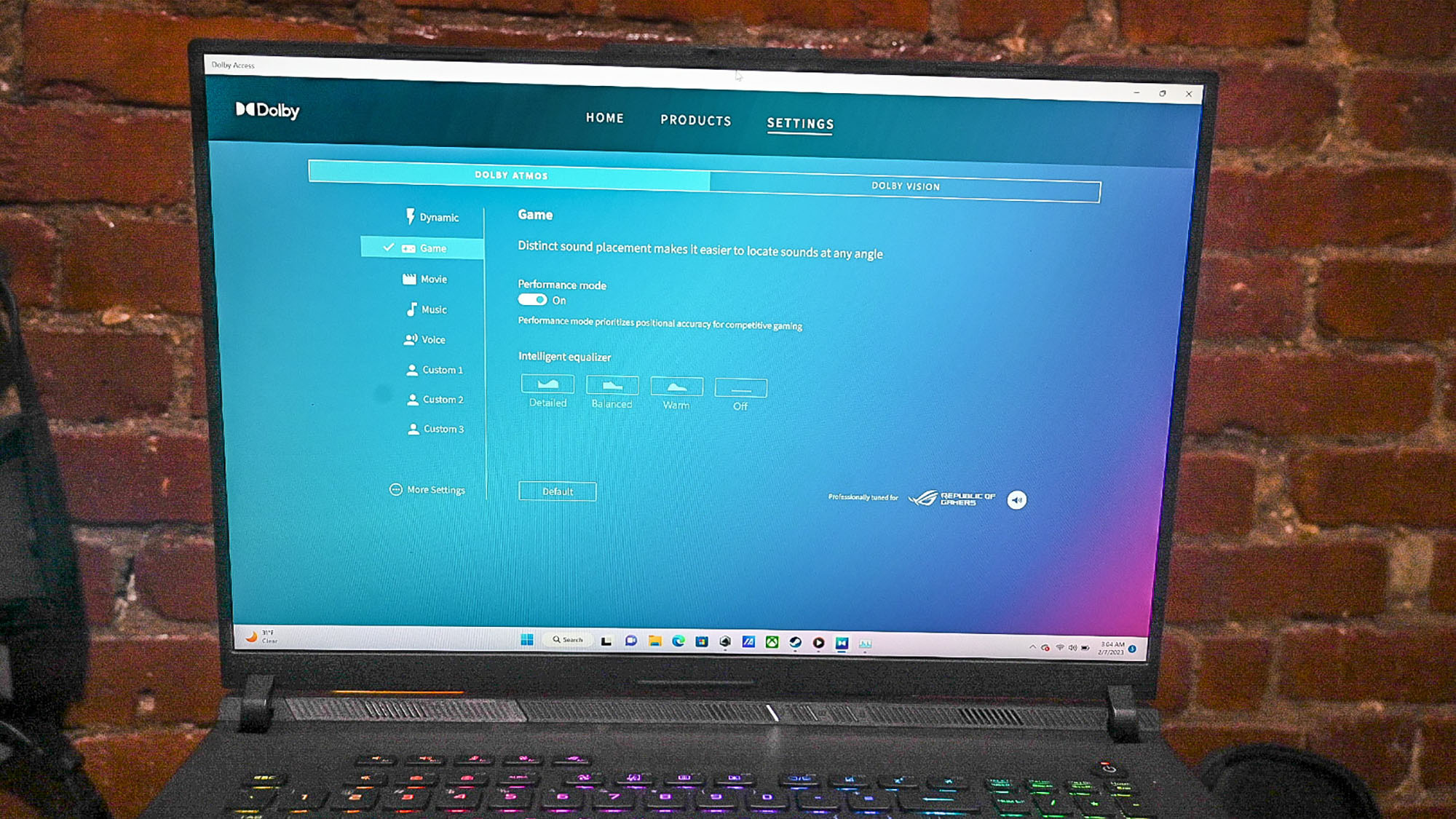
While I could use one of my many pairs of gaming headsets when playing on the Scar 18, I really didn’t feel the need. Whether it was dialogue, gunfire or the heavily synthesized, pulsating soundtrack that played during fights, the Scar 18’s audio was seriously on point. The different sounds from different guns really stuck out to me as it gave a realistic weightiness to every firearm.
Asus ROG Strix Scar 18 keyboard and touchpad
It’s like typing on little trampolines. The ROG Strix Scar 18’s full-size esport-grade keyboard is nice and bouncy. And I’m never going to say no to a Num pad. The whole setup is nicely spaced and I’m a fan of the key groupings in the Fn row, it cuts down on potential misfires while typing. Asus was also kind enough to add media and hotkeys to add to the convenience. Taking note of how the keyboard can get a little heated while gaming, the company placed small vents around the WASD keys that let the fans draw in cool air from above.
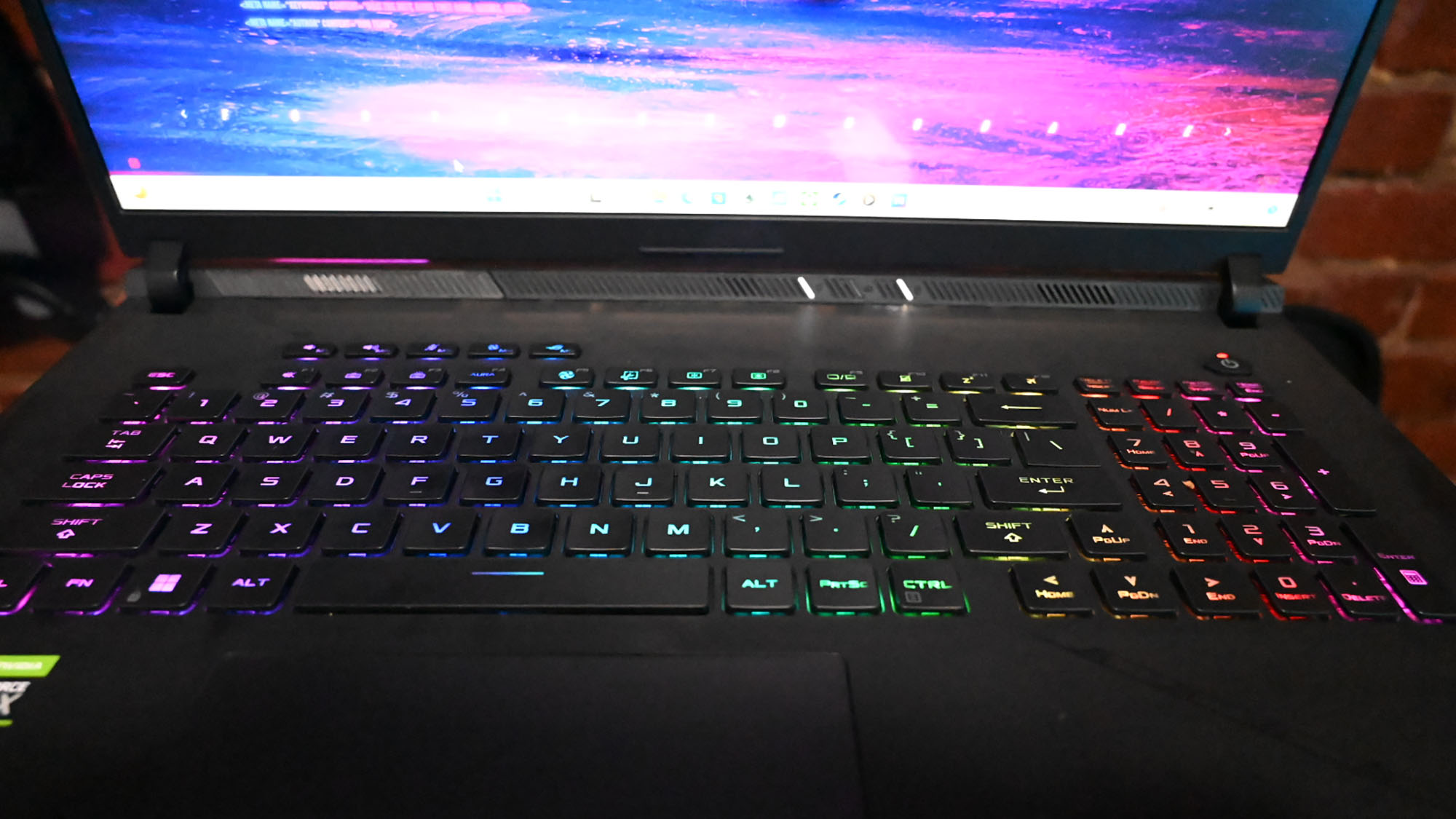
From my hair to my tech, I’m all about the RGB, and Asus gave me plenty of hues to work with. From the keyboard, rear vent and front light bar, you can customize your light show via the company’s proprietary Armoury Crate hub via Aura Sync. There you can select a color for each key as well as create macros for in-and-out of game.
If the 10fastfingers typing test is any indication, I had a blast typing on the Scar 18. I easily hit 81 words per minute, with a 1% error rate. That blows my usual 70-wpm average.
The 5.1 x 3.4-inch is huge to the tune of being 10% larger than last generation. The glass coated input device is smooth and plenty responsive, performing multitouch Windows 11 gestures in a flash.
Asus ROG Strix Scar 18 graphics and gaming
Excitement abounds! At least for me it does, as the Strix Scar 18 is the first gaming laptop I’m testing with one of Nvidia’s new 4000 series mobile graphic chips. In this case, I’m starting off at the top of the mountain with the Nvidia GeForce RTX 4090 GPU and its 16GB of VRAM. Using the company’s Ada Lovelace architecture, the company claims that it will deliver the “largest-ever generational leap in performance and power efficiency.” More than that, despite being 1/6th the size of the PlayStation 5’s GPUs it’s twice the power.
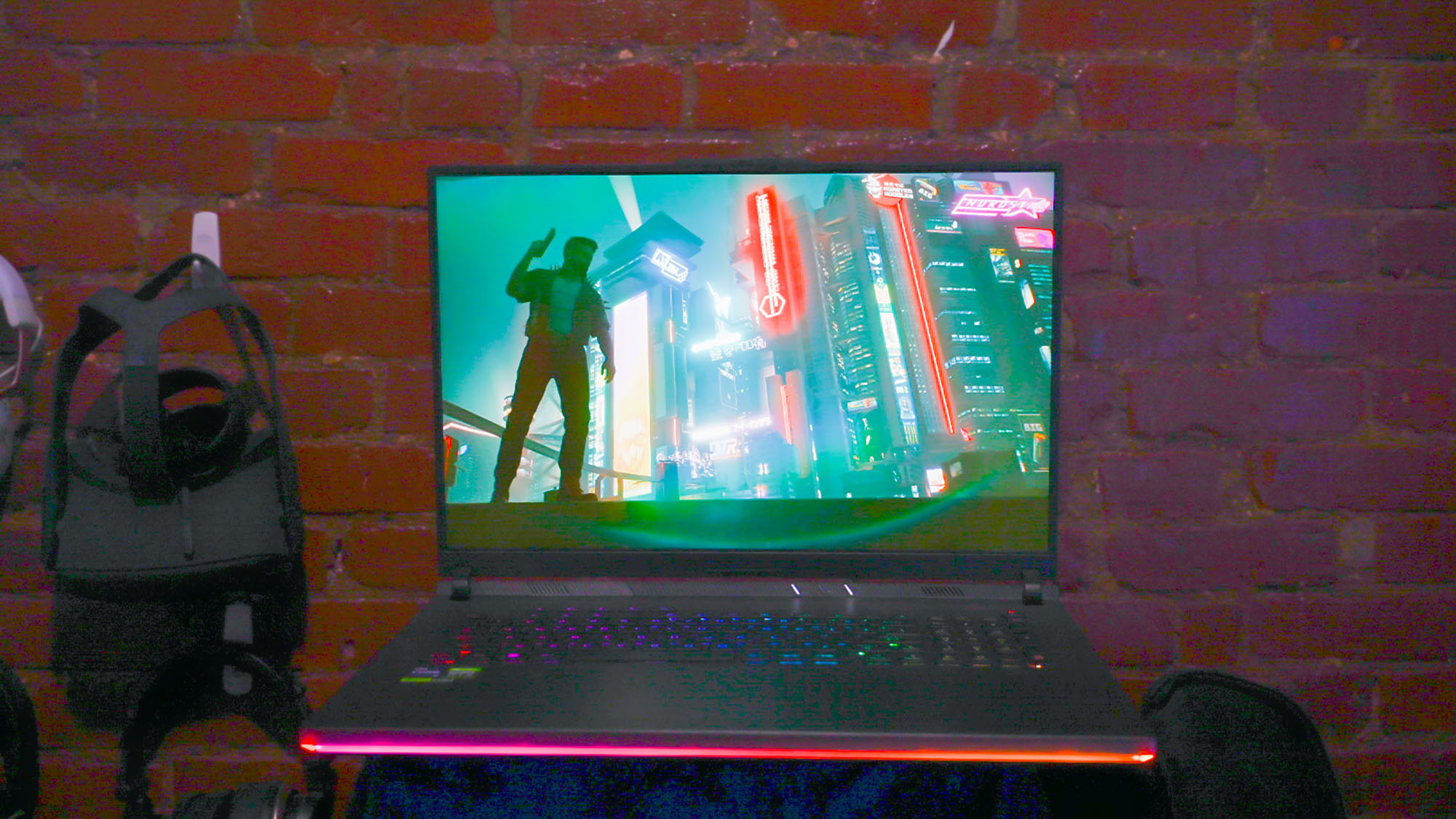
The 4090 brings with it a max 175w TGP (Total Graphics Power). And the higher the maximum TGP, the better performance you can expect. And if that wasn’t enough, Nvidia’s GPU also has a dedicated MUX switch so you can easily switch between the dedicated 4090 GPU and Intel’s integrated UHD Graphics. Otherwise, you’d have to go mucking around in the BIOS, something not every gamer is willing to do. In action, the MUX switch bypasses the iGPU in favor of the dGPU, eliminating a bottleneck and giving gamers what they crave, maximum performance.
| 1920 x 1080 | |
| Asus ROG Strix Scar 18 | 154 fps |
| Alienware X17 | 92 fps |
| MSI GE76 Raider 12UHS | 90 fps* |
| Razer Blade 17 | 89 fps |
Okay, now that all that’s out of the way, let’s get into some actual gaming and testing. When I played Cyberpunk, I cranked everything up to ultra that I could and still had some VRAM to spare. As I ran around running side quests, the lag was non-existent, even when I had to fight my way out of a sticky situation with the Asukura guards, the Scar 18 averaged a baby smooth 101 frames per second.
Now for some benchmarks. Starting with Assassin’s Creed: Valhalla, the Strix Scar 18 delivered a searing 154 fps at 1080p, cooking the 85-fps premium gaming average. But that’s not all, it also served the Blade 17, Alienware x17 and Raider all of which have last year’s heavy hitter, the Nvidia GeForce RTX 3080 Ti GPUs that reached 89, 90 and 92 fps, respectively. At native resolution (2560 x 1600), the Scar 18’s framerate dropped to 119 fps.
| 1920 x 1080 | |
| Asus ROG Strix Scar 18 | 181 ps |
| Alienware X17 | 107 fps |
| MSI GE76 Raider 12UHS | 112 fps* |
| Razer Blade 17 | 116 fps |
Over to the Shadow of the Tomb Raider test, the Asus snagged 181 fps, surpassing the 97-fps category average. The Razer came in second with 116 fps with the MSI in third at 112 and the Alienware in last place with 107 fps. At native resolution, the Strix 18 got 124 fps.
The Scar 18 notched 152 fps on the Grand Theft Auto V benchmark, crushing the 107-fps average along with the Raider (139 fps), Blade 17 (133 fps) and Alienware x17 (129 fps). Switching to native resolution, the Scar 18’s fell to 132 fps.
| 1920 x 1080 | |
| Asus ROG Strix Scar 18 | 107 ps |
| Alienware X17 | 87 fps |
| MSI GE76 Raider 12UHS | 84 fps* |
| Razer Blade 17 | 92 fps |
When we ran the Far Cry 6 test, the Scar 18 produced 107 fps, outpacing the 82-fps premium laptop average. Meanwhile, the Blade 17 reached 92 fps, the Alienware x17 notched 87 fps and the Raider achieved 84 fps. At native resolution, the Scar 18 reached 94 fps.
On the Borderlands 3, the Asus obtained an impressive 165 fps, stomping the 90-fps average as well as the Raider (106 fps), Blade 17 (100 fps) and the Alienware x17 (97 fps). On native resolution, the Strix Scar 18 got 112 fps.
Last, but certainly not least, there’s the Red Dead Redemption test where the Strix Scar 18 achieved 123 fps, trouncing the 71-fps average. The Blade 17, Raider and Alienware x17 hit 84, 82 and 78 fps, respectively.
Asus ROG Strix Scar 18 performance
Along with the Nvidia 4000 series, the Strix Scar 18 is also my first time taking one of Intel’s 32 13th Gen Raptor Lake processors for a spin. Intel’s latest series of processors are as expected faster and more powerful than their predecessors. The Scar 18 has a 2.2-GHz Intel Core i9-13900HX processor manning the ship. Intel’s HX series is the flagship of eight performance cores and 16 efficiency cores, along with up to 5.4GHz turbo frequency, offering 11% faster single-thread performance and 49% faster multitask performance over the previous 12th Gen CPUs. They’re overclockable so you can unleash even more performance.
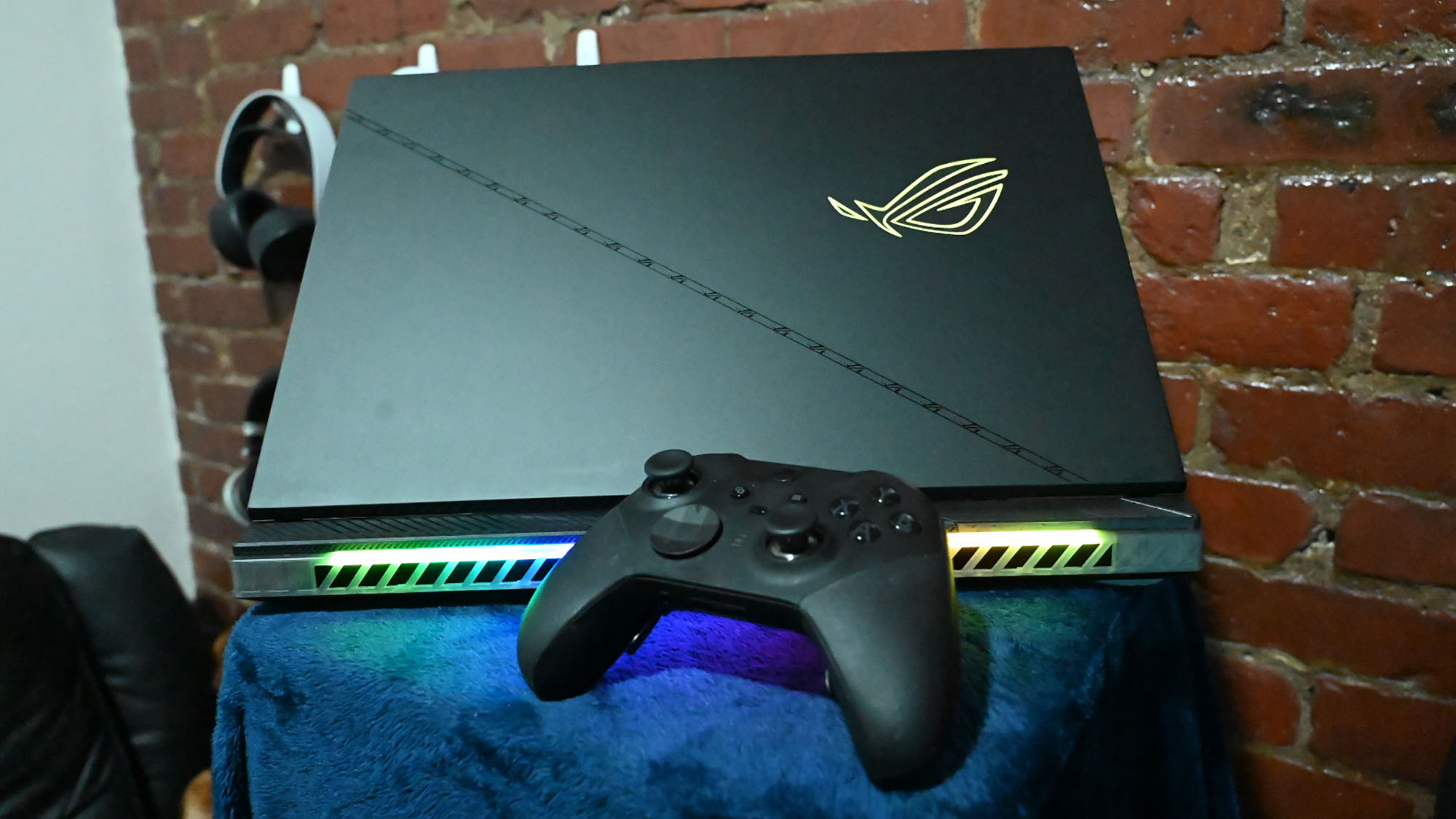
I’ve got to tell you, I tried to throw everything at the Scar 18 and by proxy its 32GB of RAM. I opened a window running Cyberpunk 2077, had 90 open Google Chrome tabs with a mix of Google Docs, Sheets and Presentations, YouTube and Twitch Streams. I threw in Facebook, Twitter and a few news and shopping sites. It didn’t matter, the Strix Scar 18 didn’t stutter.
On to the benchmarking. The Strix Scar 18 was off to the races, scoring 19,233 on Geekbench 5.4, which measures overall performance. It demolished the 8,533 premium laptop average. Equipped with last gen’s Intel Core i9-12900HK CPUs, the Raider and the Alienware x17 reached 13,456 and 13,719, respectively. The Blade 17 and its 12th Gen Intel Core i7-12800H CPU only managed 9,875.
| Mutli-core score | |
| Asus ROG Strix Scar 18 | 19,233 |
| Alienware X17 | 13,719 |
| MSI GE76 Raider 12UHS | 13,456 |
| Razer Blade 17 | 9,875 |
The Scar 18 transcoded a 4K video to 1080p in a sizzling 2 minutes and 49 seconds. That’s almost twice as fast as the 5:24 category average. The Raider came in a distant second at 4:44 with the Alienware x17 right behind at 4:45. The Blade 17 brought up the rear with a time of 7:19.
| Transfer Speed MBps | |
| Asus ROG Strix Scar 18 | 1,885.8MBps |
| Alienware X17 | 2,268.2MBps |
| MSI GE76 Raider 12UHS | 1,774.5MBps |
| Razer Blade 17 | 1,239.9MBps |
When we ran the File Transfer Test, the Scar’s pair of 1TB PCIe Gen 4.0 NVMe SSD in RAID 0 configuration posted a speed of 1,885.8 megabytes per second (MBps), cruising past the 1,289.8MBps average. The Blade 17’s 1TB SSD hit 1,239.9MBps while the Raider’s 2TB M.2 NVMe PCIe Gen 4 SSD reached 1,774.5MBps. But in a surprising turn of events, the Alienware x17’s 2TB M.2 PCIe NVMe SSD SSD won this round with 2,268.2MBps.
Asus ROG Strix Scar 18 battery life
It never fails. Something this powerful has to have an Achilles heel. For the ROG Strix Scar 18, that weakness is the battery life. The laptop only lasted 4 hours 26 minutes on the Laptop Mag battery test, falling short of the 6:03 premium gaming laptop average. The laptop outlasted the Raider’s 4:05. However, it couldn’t keep pace with Alienware x17 4:31 or the Blade 17’s 6:05.
| Hours:Minutes | |
| Asus ROG Strix Scar 18 | 4:26 |
| Alienware X17 | 4:31 |
| MSI GE76 Raider 12UHS | 4:05 |
| Razer Blade 17 | 6:05 |
To test how long the Scar 18 would last while gaming, we ran a script using PCMark 10 until the battery tapped out. The Asus laptop lasted 1 hour and 23 minutes, just edging out the Alienware X17's time of 1:19.
Asus ROG Strix Scar 18 heat
Outside of you fighting to save the day in whatever game you’re playing, gaming laptops like the Asus ROG Strix Scar 18 are fighting a battle to keep its components cool in such tight corners. To help the Scar 18 stay cool, Asus has built in a few measures including a new heatsink with a larger surface area, adding a third fan to keep the GPU and VRAM cool, just to name a few.
In order to test the cooling, we ran two tests, the first involved me playing Cyberpunk 2077 for 15 minutes and measuring key spots on the laptop. The touchpad registered a cool 79 degrees Fahrenheit while the center of the keyboard reached 91 degrees. Both temps are below our 95-degree comfort threshold. The laptop’s undercarriage exceeded the threshold at 115 degrees. The hottest point of the system sits near the hinge and measures 123 degrees.
After letting the notebook cool down, we ran a 15-minute fullscreen video and measured again. The touchpad, middle of the keyboard and bottom registered 74, 79 and 84 degrees, respectively.
Asus ROG Strix Scar 18 webcam
I was surprised and somewhat disappointed that such an expensive gaming laptop only has a 720p webcam. Still, the integrated shooter did a great job capturing color, particularly in my gray and jade green shirt. It even caught the emerald green, purple and magenta in my hair and my warm chocolate complexion. Speaking of my skin, the 0.9-megapixel, 720p shooter made it look like I had the mosaic filter enabled. And while I couldn’t read most of the text on the boxes behind me, I could read some of the decidedly fuzzy lettering.
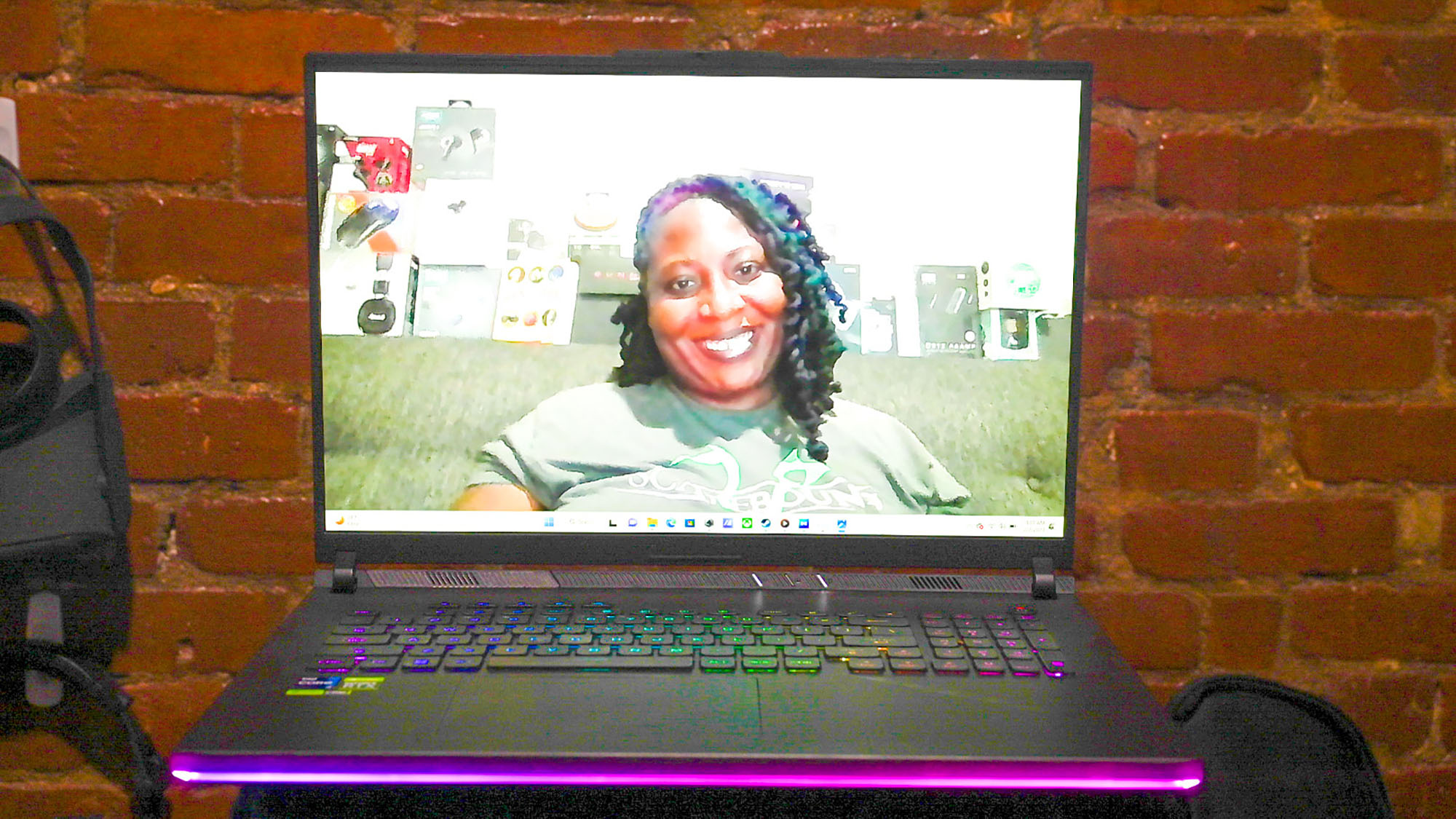
While the Scar 18’s shooter will suffice in a pinch, but if you want to stream your gaming session, I’d recommend checking out our best webcams page.
Asus ROG Strix Scar 18 software and warranty
Asus has outfitted the Scar 18 with plenty of gamer-focused software, most of which can be found in the company’s Armoury Crate, which allows you to adjust display, performance and fan speed. There are also options to toggle the Win Key, touchpad and boot up sound on and off. It’s also where you can create profiles that can be linked to specific games or apps. There’s also MyAsus where you can check the system diagnostics, battery health and warranty. You can also contact tech support and prioritize internet bandwidth.
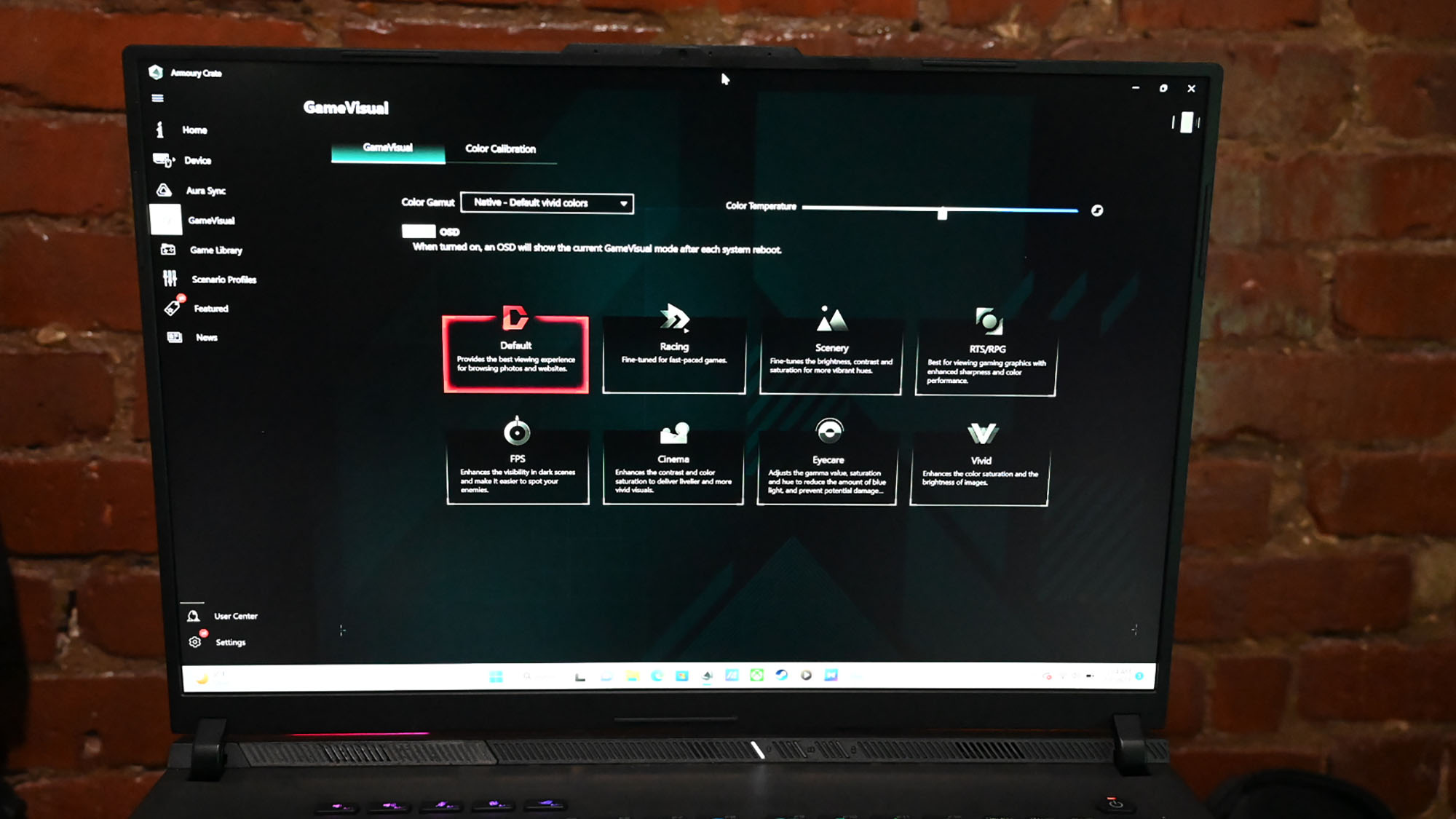
Third-party apps include Dolby Access and Nvidia GeForce Experience which allows you to prioritize network bandwidth and optimize your games' settings for gameplay.
Outside of Windows 11 apps and utilities, the Strix Scar 18 is refreshingly clear of bloatware. For security, the laptop has a 30-day free trial of McAfee LiveSafe.
The Asus ROG Strix Scar 18 ships with a 1-year limited warranty. See how Asus fared during our Tech Support Showdown and Best and Worst Brands, our annual special features.
Bottom line
I came. I saw. I kicked some ass. And I’m ready to do it again. The Asus ROG Strix Scar 18 is an absolute beast of a machine that is a joy to interact with whether you’re gaming, watching video or gasp, actually working. The display will grab your attention and never let go. That is, once you get past the futuristic design in all its transparent, customizable LED glory. From there, you’ll be sucked into Scar 18’s siren song sung by its quad speakers.
But once you get past all the flash and creature comforts, there’s the components to think of. Despite this being a Strix laptop, Asus’ mid-tier line, it didn’t skimp on the power bestowing the Scar 18 with a ridiculously powerful, overclockable Intel Core i9 processor and an Nvidia RTX 4090 GPU which is the newest king of the mobile GPUs. It’s not a system to be trifled with.
Now there are a few hiccups, some like the 720p webcam and the below-average battery life are smaller than others. The main problem with this system is the price. At $3,699, this premium system will be out of the reach of most gamers, which is a pity because the Asus ROG Strix Scar 18 has to be seen, heard and played with to be believed.

Sherri L. Smith has been cranking out product reviews for Laptopmag.com since 2011. In that time, she's reviewed more than her share of laptops, tablets, smartphones and everything in between. The resident gamer and audio junkie, Sherri was previously a managing editor for Black Web 2.0 and contributed to BET.Com and Popgadget.
